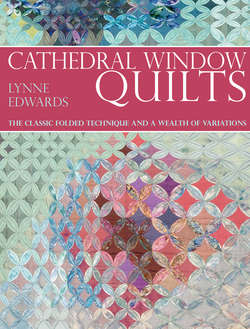Читать книгу Cathedral Window Quilts - Lynne Edwards - Страница 6
На сайте Литреса книга снята с продажи.
ОглавлениеFabrics for Cathedral Window
All my quilts start with stroking a collection of fabric, so this is for me an important aspect of any technique. I know Cathedral Window is very wasteful of fabric, but all the more excuse to buy some more, especially when the results are so gorgeous. In Cathedral Window designs there are two layers of fabrics to consider – the folded background layer plus the top layer of windows, so the choosing takes me even longer than usual.
Using the Right Fabric
Fabric for the background folded squares for Cathedral Window has to be folded into four layers and the bias folded edges pulled back into a curve, so medium-weight or even fine cotton is the best choice.
Test your fabric, in case you have one which, when pressed with a steam iron, will shrink in one direction but not the other – this happens with more fabric than you would expect. When in doubt, wash all your chosen fabric before use. I advocate this but seldom do it myself, I’m afraid. I just iron the piece of fabric before cutting it with as much steam as I can get from my iron, working on the principle that any shrinking will occur at that stage.
If you need to use a fabric that is floppy or loosely woven, spray starch it thoroughly before cutting out the squares. Once the squares are cut it is too late to starch them, as the wet fabric will distort when it is ironed dry and will no longer be an accurate square, and accuracy is important here. Spray starch firms up the fabric beautifully, making it easier to cut and prepare it for stitching. As you begin to stitch and handle the fabric, it softens again.
Batiks and hand-dyed fabrics add richness and depth to Cathedral Window projects, as seen here and overleaf. Silk windows shimmer and reflect light back at the viewer, while the background fabrics shift colour with every square. What better way to use up those collections of exciting and precious fabrics than with a Cathedral Window design?
Window Fabrics
The fabric appearing in the ‘windows’ can be made of virtually any fabric you wish to use. Stabilize flimsy or soft fabrics by backing them with a fusible (iron-on) interfacing before cutting out the windows. You can treat silky fabrics that fray badly in the same way to prevent the edges unravelling while you work. The window is placed on top of folded squares of the chosen background fabric, so you don’t have to worry about the weights being equal or the fabrics being of the same type. Consider using silk or any kind of glitzy fabric as well as cottons. Thick velvets can be hard to handle with this technique, but if you don’t mind struggling a bit, go for it. The windows need not even be made from a single fabric. For example, try foundation-piecing some miniature crazy patchwork for a window, or embellish with beads and decorative thread.
What wonderful fabrics we have now to use in our quilts: pure cottons that fold well and are as complex and organic as a painted surface; batiks and marbled fabrics in all the shades we could desire. Perfect for Cathedral Window!
The back of my wall hanging, Winter Solstice, showing how I used different blacks and greys for the folded background squares.
Making Colour Choices
I always take some time ‘cooking’ the fabrics for my pieces, arranging them on a surface, moving them around and generally getting the feel of the colour mixes.
Think of your design as two layers – the background folded shapes makes one design layer and the overlying windows makes the second, top layer. So, rather than having just one fabric for the background, find two or three that are closely related and use them for the folded layer to make a richer design. The back of my Winter Solstice quilt (below left) shows all the different blacks and greys that were used for the folded background squares in that design.
Similarly for the window design, use several shades that combine well and will look good lying on top of the background fabrics. These may be a stunning contrast like the gold windows used in Winter Solstice or a much more subtle colouring that blends in with the background layer, as in Fronds, shown right.
Start with your favourite fabric that you are aching to use and then study some of the pieces shown in the book to see which effects please you most. Add to your starting fabric with several others in the same team and once you have a good selection that will combine for the background layer, audition the second team for the overlying windows. You will have hours of harmless fun doing what we quilters really like to do best – arranging fabric, sighing over it and stroking it…
The front of Winter Solstice, showing the gold window fabrics, which glow brightly when teamed with the folded background squares.
The front view of Fronds, showing the different shaped windows in various shades of silk, which flow across the background folded layer.
Different textures and fabrics like cottons, silks and linen weaves can all be used in Cathedral Window designs, either in the folded background areas or for the overlying windows.
